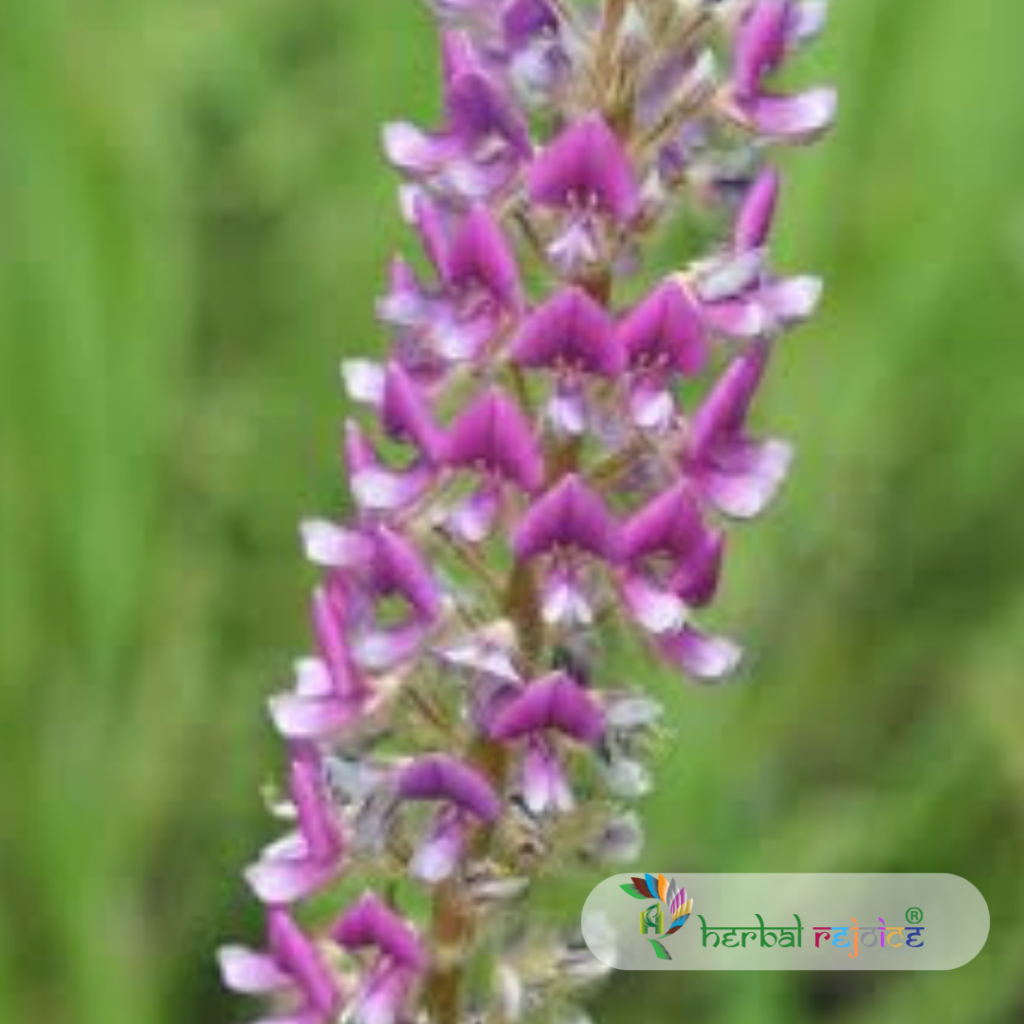Introduction
Uraria picta Desv., also known as Prishniparni, Prithakparni, Simhapushpi, Kalashi, Dhaavani, Guhaa, Chitraparni in Ayurveda, is a plant belonging to the Papilionaceae; Fabaceae family. It is native to India and can be found in dry grasslands throughout the country. In Siddha and Tamil medicine, it is known as Oripai.
Medicinal Uses
The root of Uraria picta Desv. has been traditionally used to treat cough, chills, and fevers. The leaves of the plant are believed to have antiseptic properties and are used for urinary discharges and genitourinary infections. In Ayurveda, a decoction of the whole plant is recommended for various conditions including alcoholism, insanity, psychosis, cough, bronchitis, dyspnoea, diseases caused by vitiated blood, gout, bleeding piles, blood dysentery, and acute diarrhea.

Uraria picta Desv. is also known for its potential in promoting fracture healing. Studies have shown that its total extract can enhance and expedite the healing of fractures in experimental animals. This is believed to be due to the early accumulation of phosphorus and increased deposition of calcium, essential minerals for bone health.
Dosage
To benefit from the medicinal properties of Uraria picta Desv., the recommended dosage is 20-50g of the whole plant in powdered form for decoction.
Conclusion
In conclusion, Uraria picta Desv. is a versatile plant with various medicinal applications. Its root and leaves have been used in traditional medicine for treating cough, fevers, urinary disorders, and genitourinary infections. Additionally, its potential in promoting fracture healing has been recognized. Incorporating this plant into medicinal practices can provide natural remedies for various ailments.
Frequently Asked Questions
What is the scientific name of Uraria picta Desv.?
The scientific name of Uraria picta Desv. is Uraria picta Desv.
What are some common names for Uraria picta Desv.?
Some common names for Uraria picta Desv. include Prishniparni, Prithakparni, Simhapushpi, Kalashi, Dhaavani, Guhaa, Chitraparni.
What family does Uraria picta Desv. belong to?
Uraria picta Desv. belongs to the Papilionaceae; Fabaceae family.
Where is Uraria picta Desv. native to?
Uraria picta Desv. is native to India.
Where can Uraria picta Desv. be found in India?
Uraria picta Desv. can be found in dry grasslands throughout India.
What are the traditional uses of the root of Uraria picta Desv.?
The root of Uraria picta Desv. has been traditionally used to treat cough, chills, and fevers.
What are the traditional uses of the leaves of Uraria picta Desv.?
The leaves of Uraria picta Desv. are believed to have antiseptic properties and are used for urinary discharges and genitourinary infections.
What conditions are the decoction of the whole plant of Uraria picta Desv. recommended for in Ayurveda?
The decoction of the whole plant of Uraria picta Desv. is recommended for various conditions including alcoholism, insanity, psychosis, cough, bronchitis, dyspnoea, diseases caused by vitiated blood, gout, bleeding piles, blood dysentery, and acute diarrhea.
What is the potential of Uraria picta Desv. in promoting fracture healing?
Studies have shown that the total extract of Uraria picta Desv. can enhance and expedite the healing of fractures in experimental animals.
What is the mechanism behind Uraria picta Desv’s potential in promoting fracture healing?
The early accumulation of phosphorus and increased deposition of calcium, essential minerals for bone health, is believed to be the mechanism behind Uraria picta Desv’s potential in promoting fracture healing.
What is the recommended dosage of Uraria picta Desv. for medicinal use?
The recommended dosage of Uraria picta Desv. for medicinal use is 20-50g of the whole plant in powdered form for decoction.
What are the traditional uses of Uraria picta Desv. in Siddha and Tamil medicine?
In Siddha and Tamil medicine, Uraria picta Desv. is known as Oripai and is used for various purposes.
Does Uraria picta Desv. have any antiseptic properties?
Yes, the leaves of Uraria picta Desv. are believed to have antiseptic properties.
Is Uraria picta Desv. used in the treatment of genitourinary infections?
Yes, the leaves of Uraria picta Desv. are traditionally used for genitourinary infections.
Can Uraria picta Desv. be beneficial for individuals with gout?
Yes, in Ayurveda, the decoction of the whole plant of Uraria picta Desv. is recommended for gout.
Can Uraria picta Desv. be used to treat bleeding piles?
Yes, in Ayurveda, the decoction of the whole plant of Uraria picta Desv. is recommended for bleeding piles.
Can Uraria picta Desv. be used to treat psychosis?
Yes, in Ayurveda, the decoction of the whole plant of Uraria picta Desv. is recommended for psychosis.
Can Uraria picta Desv. be used to treat bronchitis?
Yes, in Ayurveda, the decoction of the whole plant of Uraria picta Desv. is recommended for bronchitis.
Can Uraria picta Desv. be used to treat dysentery?
Yes, in Ayurveda, the decoction of the whole plant of Uraria picta Desv. is recommended for blood dysentery.


